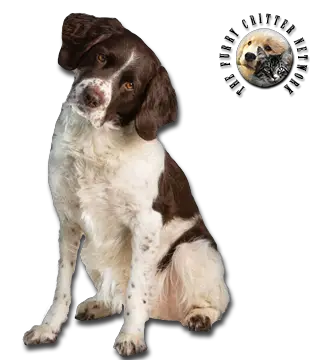Breed Standard
Head: Broad and flat. Slight stop. Straight nosebridge. Wedge-shaped muzzle. Brown nose.
Ears: Covered with long hair, hanging flat against the cheeks.
Eyes: Amber.
Body: Compact. Deep chest. Long ribs. Broad loin. Powerful back. Fairly long, slightly sloping croup.
Tail: Long, hanging down at rest, raised in action.
Hair: Thick, medium in length on the body. Feathering on the ears, legs, and tail.
Coat: White with brown or orangish spots.
Size: Dog: 57 to 63 cm (22,5-24,8 in).Bitch: slightly less.
Weight: 20 to 25 kg (44-55 lb).
History
The origins of the Drentsche Patrijshond are in the 16th century, from the Spioenen (or Spanjoelen) which came to the Netherlands through France from Spain, and is related to the Small Munsterlander of Germany and the Epagneul Français of France. In the Netherlands, these dogs were called partridge dogs.
The presence of the partridge dogs had been visible for centuries. Before formal recognition as a modern breed in 1943, the type had been kept separate from other dogs as an undocumented breed for centuries in the rural province of Drenthe. As the Drentsche Patrijshond is a breed developed in the Netherlands, the breed standard was first developed and approved in 1943 by the Raad van Beheer op Kynologisch Gebied (Dutch Kennel Club), the Federation Cynologique Internationale national kennel club for the Netherlands. The Federation Cynologique Internationale recognised the breed using the standard developed by the breed's country of origin as the standard to be used in international competition. The United Kennel Club in the United States also recognises the breed using the outdated (February 1994) Federation Cynologique Internationale standard.
In November 2010, the AKC recognized the Drentsche Patrijshond Club of North America (DPCNA) and the Drentsche Patrijshond was added to the AKC Foundation Stock Service Program, allowing owners of registered Drents to participate in AKC sanctioned events such as hunt tests and agility competitions, starting in 2011.
Behavior
Though the breed shows a strong hunting instinct in the field, and can be quite driven, these dogs tend to be more relaxed in the home than many of the hunting breeds. They are strongly attached to family members, loyal, and of sweet disposition, particularly with children.
Happiest when working alongside a hunter, the Drent enjoys the company of humans in the great outdoors. Several brisk turns around the park will satisfy it as well. Although it will come home and quietly assume its position on its bed, it should not be mistaken for a sedentary dog, the breed will suffer if insufficiently exercised.
Function
The province of Drenthe 300 years ago was unusual, in that it allowed the common gentry the right to hunt. The local mayor, the farmer, and landowners in general developed dogs to support their pursuit of various small game. Unlike many other hunting breeds, which were developed by, and for, the elite or nobility only to hunt, the Drentsche Patrijshond was expected to hunt all game, and also pull duty as watch dog, child playmate, etc. Some were even used to pull the dog-carts of the day. For over 300 years, the Drentsche Patrijshond type has been an all-around dog.
Perfectly suited to the walk-up (upland) hunter, the Drent is thorough, in order to find all the game on the smaller plots available in Drenthe. It hunts with good speed, within reach of the gun. As with most European versatile breeds, the Drentsche Patrijshond points and retrieves, and will hunt both birds and small mammals, including rabbit, hare and fox. Today, the Drent is a favorite gun dog throughout its native country of the Netherlands, with approximately 5,000 dogs registered with the breed club.
Health
Breed health concerns may include progressive retinal atrophy (PRA) and hereditary stomatocytosis.






